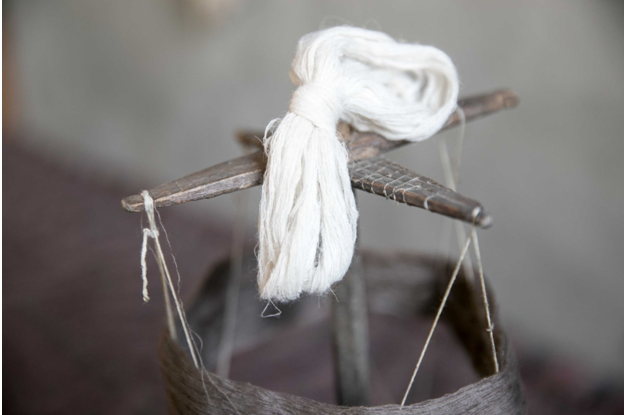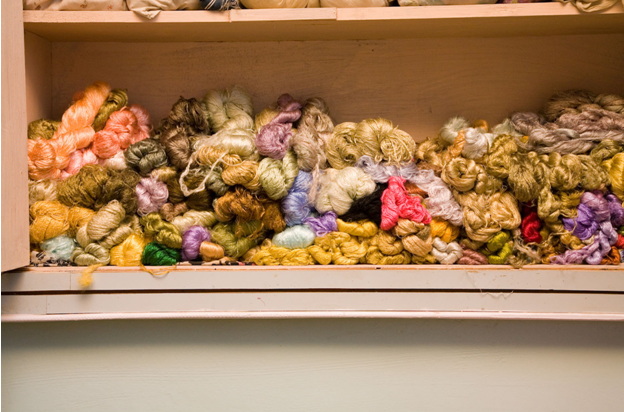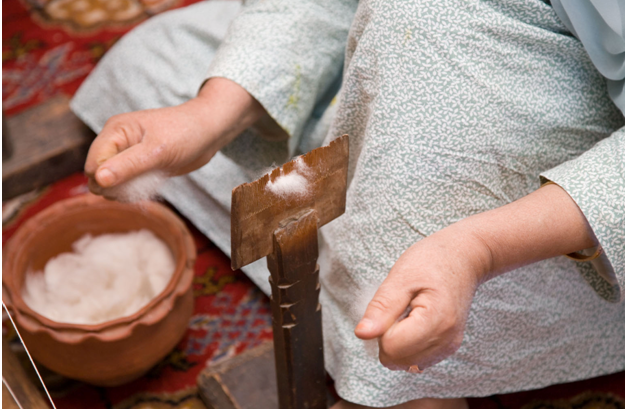
Stick to nature is the best thing a human being can do. The co-existing of humans and nature was a happy tale until artificial products take over the market. The initial pomp and shower of the synthetic items captivate the attention of the human being. With time, people come to understand the terrible effects of those non-natural and factory-made products.
Lately, they have become more aware and conscious to select every product for themselves. This scenario is quite common in the fabric industry as well.
Initially, people used to weave from natural fibers like cotton, Pashmina, wool, and silk. To meet the growing demand for fabric, people started to create synthetic products like nylon, polyester, viscose in the factory. They become instantly popular for their longevity and versatility. The designers can expand their creativity and produce long-lasting dresses.
However, gradually, the artificial fabrics started to show issues. Most of the artificial materials are not comfortable. The fabrics are not breathable and for that reason, the skin will not get the required comfort. During summer, problems like sweat, itching, and rashes are very common in synthetic material. It does not allow ventilation and for that, the sweats don’t get the scope to evaporate. The moisture-absorbent capacity is also very poor for the synthetic material.
Apart from that, people with sensitive skin always have a problem with synthetic materials like nylon and polyester. These fabrics will irritate their skin. Here we will discuss in detail the common problems one with skin sensitivity can have from synthetic fabric are.
Check out the causes of Skin Irritation From Fabric:
People with skin sensitivity must be very cautious while selecting the fabric.
People who have skin conditions like psoriasis, contact dermatitis and eczema, and allergies to wool, spandex, or latex; must take extra precaution while selecting the clothing. The cancer patients who are undergoing radiotherapy or chemotherapy and have skin reactions from those treatments don’t find comfort in non-natural fabric. Most of the time, they are advised to wear natural fabrics especially silk to get maximum comfort and relief to the sores and rashes.
Due to menopause and aging, the collagen and natural moisture start to lose and skin gets dry with time. For that reason, people with no skin problem in their youth start to get problems with artificial fabrics.
People with serious skin sensitivity problems often get relief wearing natural fabrics like cotton, silk, and Pashmina. While selecting the clothes, they must be careful and check whether there is any sort of blend of latex or other chemically treated fiber. The blending will surely take away the goodness of the natural fabric and will make you uncomfortable. Always check the label of the garment and the waistband and threading section to find out whether it has non-natural fabric that can cause irritation or not.
Know Why People Prefer Natural Fabrics:

Natural fabrics like cotton, silk, linen, and Pashmina are completely made from natural products. With time, the quality of the products is getting better. People are now producing natural fabrics from bamboo as well.
When it comes to natural fabric, it has so many benefits of using it. Let’s take a look at the advantages of those organic and sustainable garment options which are good for health.
The Advantages You Can Enjoy With Natural Fabrics:
- They are breathable: There is no question in breathability competency of natural fabrics. All of the natural fibers come up with high absorption quality. In case of excess moisture, it will allow excellent ventilation to dry out the dampness. For that reason, you can wear comfortably cotton and silk even the weather is extremely hot and sweaty. It will not cause rashes and itching on the skin. On the other hand, synthetic fibers like polyester and acrylic cannot soak water as they are water-resistant in nature. For that reason, they don’t have the moisture-wicking capability. Moreover, due to their zero water absorption nature, people feel uncomfortable, clammy, and sweaty in hot weather.
- They are hypoallergenic in nature: Silk, cotton, linen, and bamboo fibers are hypoallergenic in nature. Moreover, they have anti-bacterial properties that will protect the user from microbes attack. For example, we can say that the bamboo fabric has a unique anti-bacterial bio-agent which is called the bamboo Kun. Surprisingly, that natural anti-microbe agent can survive the fiber-making process and thus makes the fabric natural anti-bacterial, fungal-resistant, and odor-free. For that reason, it is advisable to use a silk bed sheet for people with hyper skin sensitivity. For babies, using the Pashmina Blanket is the most ideal choice. Synthetic fibers like polyester, nylon, and rayon can create skin irritation and eventually lead to severe health issues. To produce these man-made fabrics; the process involves extensive chemical treatment for which these products can cause rashes and skin irritation or even can start allergy.
- They are great insulators: Surprisingly, all the natural fabrics have self thermal adjusting capability. While skiers are on the slopes, they used to wear silk to control their body temperature. Fabrics like wool, bamboo, and silk captivate air in between the creases, bends, and micro-holes. That’s why; the trapped air in between the fabric holes generates warmth in the wintertime and cooling in the winter.
- They are sustainable: As the world is moving towards sustainable solutions; natural fabrics are the best choice. The materials come from trees, plants, and animals and thus these can be replaced and regrown with time. These biodegradable fabrics will decompose without making any harm to nature when they are on the threshold. Moreover, people can recycle and reuse them to get something new. On the other hand, the synthetic fabrics which are made through chemical process emit greenhouse gases and take more energy and time to decompose or recycle.
What are the effects of artificial fabrics on health?
People who have sensitive skin may feel irritation and rashes after wearing clothes made from synthetic materials. As per the study, the main crisis-makers are:
- Chemicals like formaldehyde and Para-phenylenediamine (PPD)
- Latex and spandex
- Dyes like disperse blue 1, anthraquinone, and Azo
- Wool (especially for the dry and sensitive skins)
On the other hand, natural fabrics don’t have such problems and for that reason, they are known as skin-friendly material. It is advisable for people with sensitive skin issues to avoid fabrics like nylon, polyester, acrylic, triacetate, and Acetate. As these fabrics are not natural, there are synthetic polymers in polyester and petroleum in nylon.
While shopping, you can easily make a clear choice of selecting the garments that are skin-friendly, there is still scope that the labels can deceive you. If you want to minimize your toxin exposure; you must know the following things.
What is the actual meaning of the labeling on clothes?
The garments manufacturers try to hide some facts and attract buyers with lucrative marketing phrases. So, here are some labels and their meaning and effects on health.
- Wrinkle-free: It is a very common label especially made for today’s fast-moving generation. The clothes with this label can release formaldehyde. In the process, after they do the textile dye, the blending of textile finish resin and formaldehyde often start an allergic reaction. The chemical can irritate the mucous membranes as well as the respiratory tract.
- Colorfast: The clothes with this label use dye fixatives that bond the colors to the texture. Unfortunately, these dye fixatives have heavy metal makeup which the skin absorbs and then accumulates in different organs like the liver, kidney, heart, bones, and brain. It can also leak into the environment and make an awful effect.
- Stain-Resistant: To make the fabric stain resistant, there may be Formaldehyde or Perfluorinated chemicals (PCFs).
- Moth Proof or Shrink Proof: There is Formaldehyde in the clothes with the label.
- Flame Retardant: Especially these types of materials use Polybrominated diphenyl ethers or PBDE, the chemical additive which is highly toxic. This chemical can be found in the breast milk of the nursing mother or even clothes dryer lint and house dust.
- Wash Separately from other Garments: This label denotes a high concentration of dye that is used on the fabric. Generally, dark blue, black, and brown colors of fabric dyes can be absorbed by the skin and eventually cause allergy. You have to keep in mind that the dye that can bleed in the washer can do the same thing to your skin as well.
Discover more about natural fabrics

So, we have become aware of the fact that natural fabrics are far better than synthetic fabrics. Now we will learn about all the known natural fabrics and the advantages of wearing them.
Cotton: Among all-natural fabrics, cotton is the most popular yet low maintenance one. It is naturally hypo-allergic and for that, it has anti-bacterial quality. It is a perfect choice for people with sensitive skin. This powerhouse fabric does not irritate your skin. Moreover, it let the skin breathe freely. For people who often face hot flashes after wearing synthetic material, cotton is the best choice.
Here we list down all the benefits of this soft material for your health.
Cotton is:
- Breathable
- Easy to evaporate excess moisture
- Soft
- Biodegradable
- Produced naturally and organically
Silk: This is another exquisite and luxurious fabric that is also hypo-allergic due to its protein structure. Surprisingly, it is low-maintenance as well. People with severe skin issues are advised to use silk pillowcases and bedsheets as it will reduce itchiness and irritation. It is also a great remedy for nighttime sneezing. This excellent natural fabric will keep you cool in the summer and give warmth during the cold season. This material is soft on the skin yet very hard and strong. In case you have to dry it indoors, it will have any sort of dump smell like any other fabric.
Here are the qualities of silk as the natural fabric.
Silk is:
- Breathable
- Soft and luxurious
- Biodegradable
- Durable
- Lightweight yet warm
- Natural fungal repellent
Pashmina: When we are discussing the natural fabric, Pashmina is an obvious choice. It is the most luxurious fabric as the production process is completely manual, natural, and organic. People with sensitive skin can wear a Pashmina shawl in the winter to avoid itchiness or artificial woolen products. The texture is so soft and breathable that it is an ideal option for the babies as well. It absorbs the excess moisture from the skin and keeps you comfortable.

Advantages of Pashmina for health are listed below.
Pashmina is
- Breathable
- Easy to evaporate excess moisture
- Soft and luxurious
- Biodegradable
- Lightweight yet warm
- Bacteria repellant
Wool: It is known as the most common material for the winter season. It is not only antibacterial but also resistant to dirt and dust mite. Due to its excellent absorbent quality, it will keep surrounding clean and dry. It has been seen that the presence of this material reduces the number of allergens. Wool has been recommended to get rid of conditions like asthma, upper respiratory tract infection, and skin diseases.
Here is the list of benefits you can have from wool.
Wool is:
- Absorbent
- Warm
- Durable
- Free from pesticides and chemicals
Linen: The fibers of linen are made from the flax plant and it is known as one of the strongest fibers of the world. Surprisingly, it gets stronger when gets wet. It regulates the temperature of the body. This excellent fabric has antibacterial and anti-fungal properties. It is non-allergic and anti-static properties as well. It can also absorb 20 percent of moisture without feeling wet.
Here are the advantages of the linen fabric.
Linen is:
- Breathable
- Lightweight
- Durable
Bamboo: This is another sustainable option of the natural fabric. The natural fibers of the bamboo plants are spanned to bring out exclusive, soft yet durable fabric. This breathable fabric is commonly used to produce flannel, nappies, or reusable sanitary napkins. It is completely hygienic because it hinders the breeding of bacteria for its anti-bacterial properties. Moreover, this fabric is very absorbent as well as eco-friendly. However, this fabric is more used as wipes and washcloths rather than clothing.
Let’s know about the advantages of Bamboo Fabric in the following section.
Bamboo fabric is:
- Biodegradable
- Soft
- Moisture absorbent
- Anti-bacterial
So, if you are reorganizing your wardrobe, then you must go for the natural fabrics to stay comfortable all through the seasons. In case, you don’t get 100% natural fabric in the store then select a 90:10 proportion of natural and synthetic blend in the cloth. Also, make sure to wash every cloth that has synthetic material as it may contain toxic chemicals and can be harmful to health. Remember, to stay healthy, wear natural fabric.